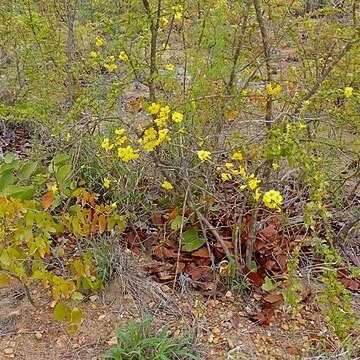Leaves 13–40 mm. long, (2) 3–5-jugate, very rarely 1-jugate, solitary or clustered in small almost glabrous cushions situated below the spines; petiole 4–9 mm. long; rhachis winged; leaflets 5–9 (14) × 3–4.5(6) mm., ovate, obovate, elliptic or rounded, sometimes emarginate at the apex, narrowly tapering or broadly acute at the base, margins entire, sessile.
Corolla golden-yellow, with the tube 10–17 mm. long, glabrous lower cylindrical part slightly exceeding the calyx; lobes 8–13 mm., subcircular, crenulate, margin ciliate, puberulous on the inner surface at the sinuses, becoming glabrous at last.
Small tree or shrub, up to 4 m high. Leaves imparipinnate with leaflets (1)2-5-jugate, rhachis winged, solitary or clustered in small almost glabrous cushions, petiole ± 4-9 mm long. Flowers golden-yellow.
Spiny shrub or small tree up to 4 m. tall (reaching 7 m. outside Flora Zambesiaca area), with rigid spreading branches with smooth greyish-brown bark, with shallow longitudinal ridges.
Stamens adnate up to c. 8 mm. from the base of the corolla tube; filaments c.5 mm. long; anthers 4–5.5 mm. long, slightly apiculate, exerted from the corolla tube.
Calyx 3–5 mm. long, subglabrous, 5-lobed, usually pilose at the apex.
Flowers solitary or clustered on the cushions; pedicels 2–5 mm. long.
Seeds 1–1.3 × 1.7–2.2 cm., including the wings.
Capsule 3.5–8 × 1.2–2 cm. beaked, pale brown.
Ovary c. 2mm. long; style 11–17 mm. long.


